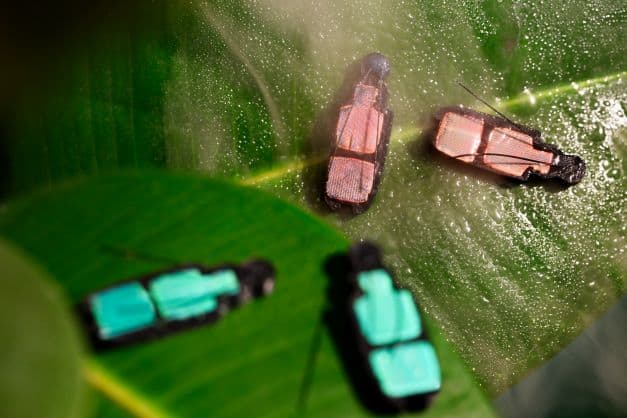4D-printed material responds to environmental stimuli
27 Jul 2022
Beetling along: Under the influence of moisture, the colour of the 3D-printed beetle changes from green to red, and back again to red. (Courtesy: Bart van Overbeeke)
Researchers in the Netherlands have produced models of a beetle that changes colour and a scallop shell that opens and closes in response to changing humidity in the surrounding air. Inspired by iridescent structures in nature, Jeroen Sol and colleagues at Eindhoven University of Technology showed that they could integrate a specialized liquid crystal into standard 3D-printing techniques, creating “4D printed” devices that react to their changing environments.
Over millions of years, many organisms have evolved micro-scale structures in their anatomies that allow them to change their vibrant iridescent colours in response to stimuli. Recently, researchers have developed inks that change colour in the same way and have begun to experiment with incorporating them into 3D-printed structures.
This technology has been dubbed 4D printing, where the fourth dimension represents reversible, time-varying changes to the structures after printing. One widely used technique in 4D printing is to deposit ink directly onto 3D printed structures. This approach can accommodate many types of material, as well as a versatile range of printing temperatures, speeds and path designs.
Liquid crystals respond to environmental changes
A particularly promising class of inks for 4D printing are cholesteric liquid crystals (ChLCs). In conventional liquid crystals, molecules flow like a liquid while still orienting themselves like a solid crystal. In ChLCs, molecules arranged across multiple vertical layers can adopt spiral structures in their orientations. Crucially, these structures can be easily and reversibly varied in response to the presence of water, certain chemical compounds and mechanical forces – all of which alter their optical characteristics.
In their study, which they describe in Advanced Functional Materials, Sol and colleagues took inspiration from a species of longhorn beetle (Tmesisternus isabellae) that changes its iridescent colour in response to humidity. To reproduce this effect, the researchers incorporated ChLC ink onto the back of a 3D-printed beetle, then treated this layer with acid in such a way that its crystal structure would respond to moisture.
In high-humidity conditions, the ink swelled. This altered its spiralling molecular structure, causing the beetle’s vibrant iridescent colour to transform from green to red. Once the humidity was removed, the ink reverted back to its original structure, and the beetle turned green again.
An open and shut case
In a parallel experiment, Sol and colleagues printed an open scallop shell from a ChLC elastomer material prone to swelling in high humidity. The team then treated one side of the shell with light to remove this humidity response, while treating the other side with acid as they had with the beetle. This meant that when exposed to dry air, the acid-treated side shrank, causing the shell to clamp shut, only to open again once humid air was restored.READ MORE

Sol’s team says that these reversible, stimuli-responsive behaviours could inspire applications in robotics and sensing technologies. They could be particularly useful in healthcare, where affordable, wearable 3D printed devices would allow patients to monitor their symptoms simply by tracking the devices’ variable iridescent colours.
Sam Jarman is a science writer based in the UK.
from physicsworld.com 29/7/2022

Δεν υπάρχουν σχόλια:
Δημοσίευση σχολίου